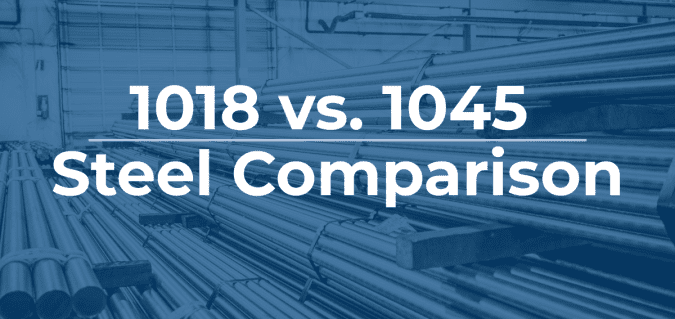
The 1018 and 1045 grades of carbon steel are some of the most widely used materials in the world, particularly in their cold drawn steel bar forms. However, many struggle with differentiating between the two steel grades and deciding which grade would be best for their project. As experts in all things steel, we compiled the key differences and similarities to help you better understand which is best for your needs.
Chemical Properties of 1018 & 1045 Carbon Steel
1018 steel and 1045 steel undergo different manufacturing processes that ultimately create some distinct differences in their chemical properties. Please reference the table below to learn the chemical properties of each grade.
| Element | 1018 Steel | 1045 Steel |
| Iron, Fe | 98.81 – 99.26% | 98.51 – 98.98% |
| Carbon, C | 0.18% | 0.45% |
| Manganese, Mn | 0.60 – 0.90% | 0.60 – 0.90% |
| Phosphorus, P (max) | 0.04% | 0.04% |
| Sulfur, S (max) | 0.05% | 0.05% |
The carbon content of steel determines the grade a given steel falls under. The carbon content of 1018 steel is 0.18%, and the carbon content of 1045 steel is 0.45%. The “1” identifies that they are both carbon steels, and the “0” identifies that there were no modifications to the alloy. So, the carbon content is the true differentiator between the chemical composition of 1018 and 1045 steel, with 1045 steel having a higher carbon composition.
Mechanical Properties of 1018 & 1045 Carbon Steel
The mechanical properties of steel depend heavily on whether the steel is cold drawn or hot rolled. The majority of manufactured 1018 and 1045 steel will be in the cold drawn state in a wide range of shapes and sizes. The chart below compares the mechanical properties of 1018 and 1045 cold drawn steel:
| Mechanical Property | 1018 Cold Drawn Steel | 1045 Cold Drawn Steel |
| Tensile Strength | 64,000 psi | 91,000 psi |
| Yield Strength | 54,000 psi | 77,000 psi |
| Elongation in 2” | 15% | 12% |
| Reduction in Area | 40% | 35% |
| Brinell Hardness | 126 | 179 |
Applications of 1018 & 1045 Carbon Steel
With its higher carbon content and higher tensile strength, 1045 steel is stronger steel than 1018 steel. However, because of its higher carbon content, 1045 steel is more difficult to weld. Therefore, we recommend 1018 steel for applications that involve welding or require a larger quantity where tensile strength and yield strength are not of the utmost importance. Contrarily, most select 1045 steel for product applications that require more strength than 1018 can provide, such as transmission parts.
Cost of 1018 & 1045 Carbon Steel
As 1018 steel can be utilized for a wide range of applications, it is widely manufactured and thus more cost-effective than 1045 steel. While 1018 steel will generally be a lower cost steel when compared to 1045, many other factors can influence the overall cost like heat treatment and processing needs.
Connect with Capital Steel for Your Steel Needs
Still have some questions or need assistance ascertaining which steel grade is best for you? Reach out to our team of steel experts for any questions or inquiries. We are always ready and happy to help.





